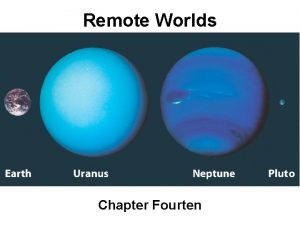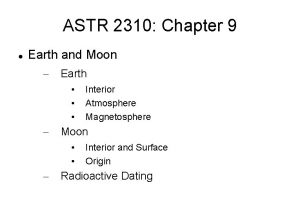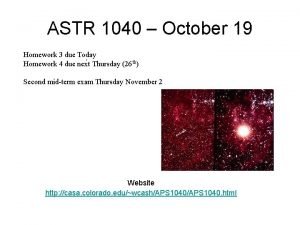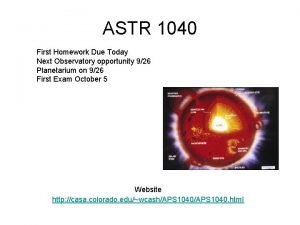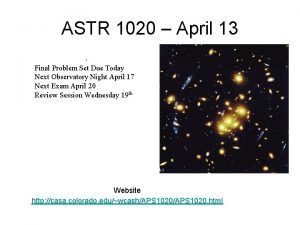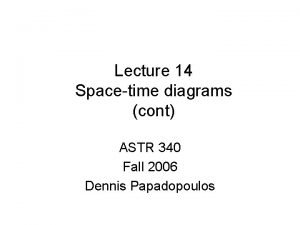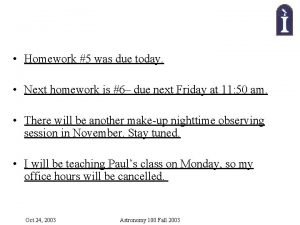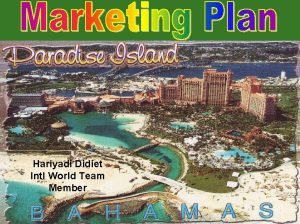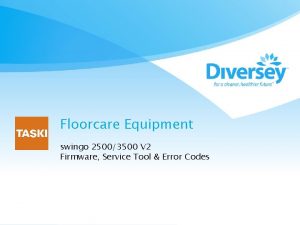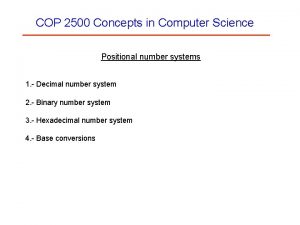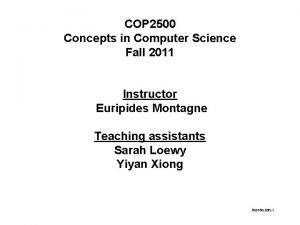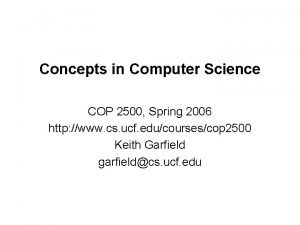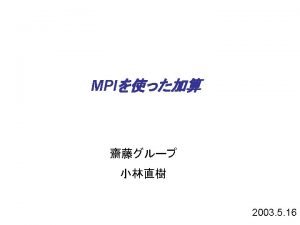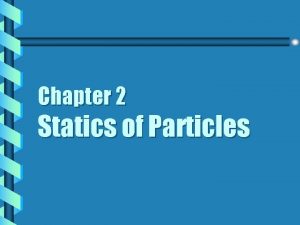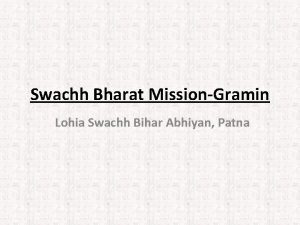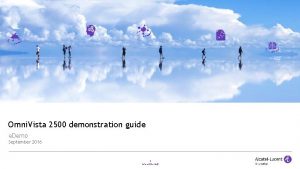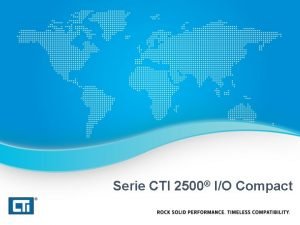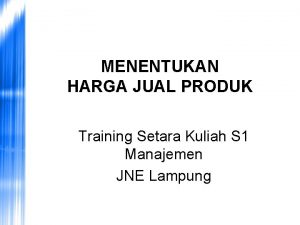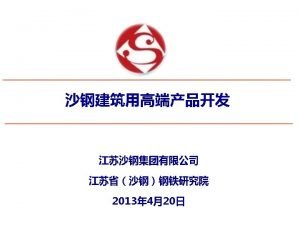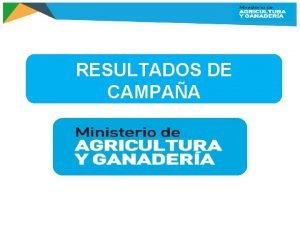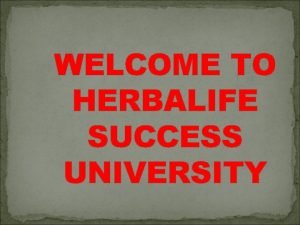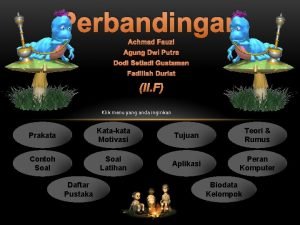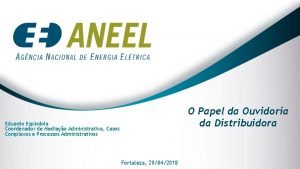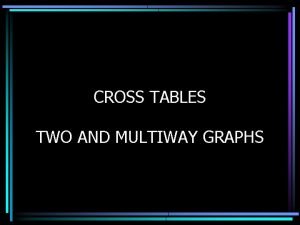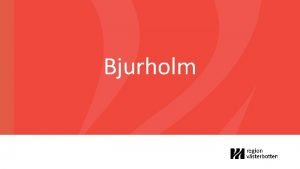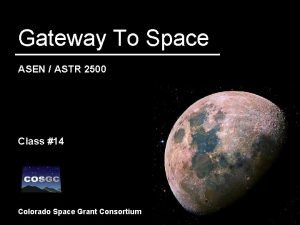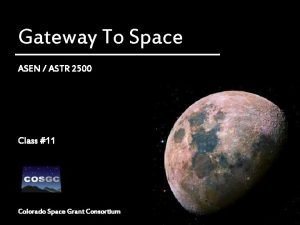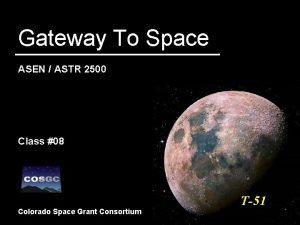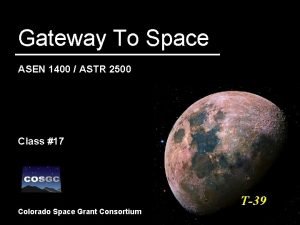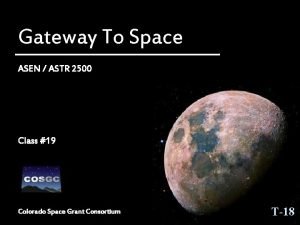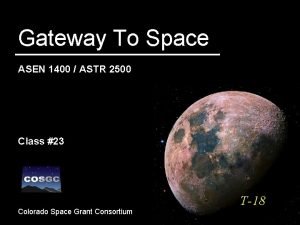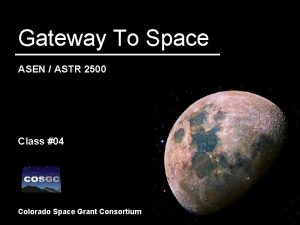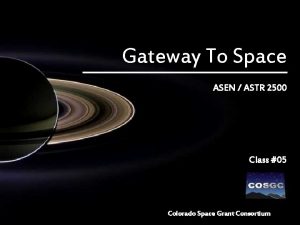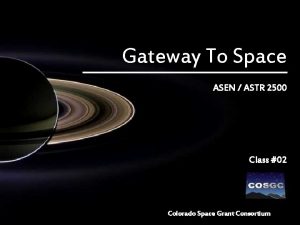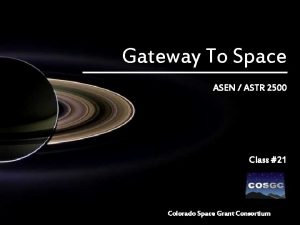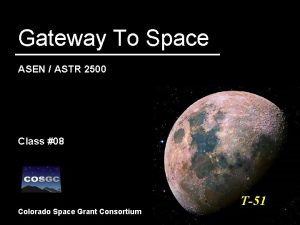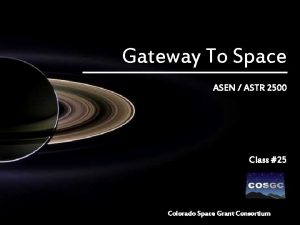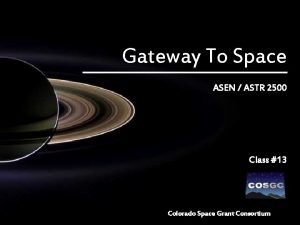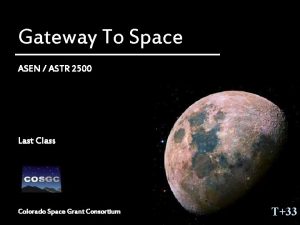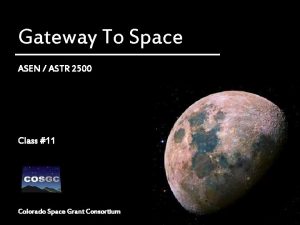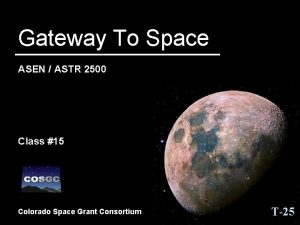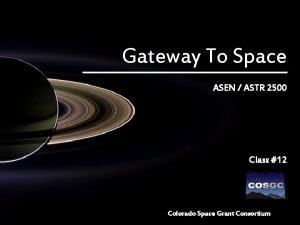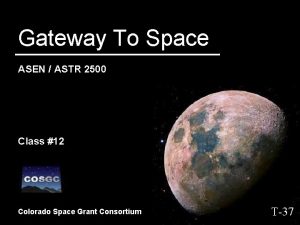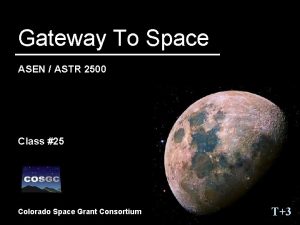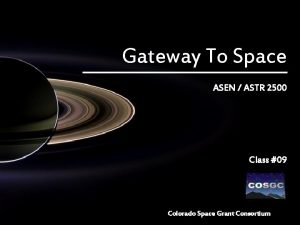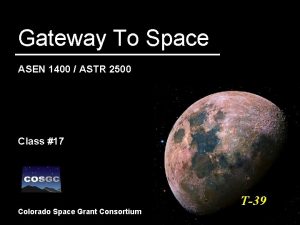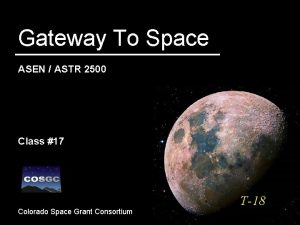Gateway To Space ASEN ASTR 2500 Class 08

















![Bi-directional Requirements. Traceability Flow [System to Item Overview] System Requirements/Des ign Analyze System Requirements Bi-directional Requirements. Traceability Flow [System to Item Overview] System Requirements/Des ign Analyze System Requirements](https://slidetodoc.com/presentation_image_h/d97c0c54109c9d910e5fc0b3d1f2b38f/image-18.jpg)
![Bi-directional Requirements Traceability Flow [Verification Activity] • A verification matrix that provides the map Bi-directional Requirements Traceability Flow [Verification Activity] • A verification matrix that provides the map](https://slidetodoc.com/presentation_image_h/d97c0c54109c9d910e5fc0b3d1f2b38f/image-19.jpg)

























- Slides: 44

Gateway To Space ASEN / ASTR 2500 Class #08 Colorado Space Grant Consortium 1

Announcements: 2

Today: - Best Class guest lecture we have had this semester - Announcements - Next time is Team Time - Attendance will be taken but then… 3

Announcements: - Thanks for everyone’s extra effort on Sunday - Especially want to thank those that helped set up and tear down > Kathleen B. > Anthony C. > Jordan D. > Blake F. > Chris K. > Tiffany M. > Emily F. > Charles H. > Kirstyn J. > Chris K. > Michael L. > Matthew P. - Next Sunday Training is September 27, 2009 4

Announcements: - Proposals are due Thursday at 6: 00 PM via email - Next Tuesday will be Conceptual Design Reviews - Each team will have only 5 minutes to present - Going over 5 minutes will hurt your grade - Each team member will be in the front of the room and shall help with the actual presentation 5

Announcements: - Grades will be posted by Wednesday evening on the class website - You will need your password - Your password will be emailed to you by Jennifer 6

Questions? Colorado Space Grant Consortium 7

Today… We have our first guest lecturer of the semester. Topic is System Engineering Let’s welcome… Julia Chu from Lockheed Martin 8

Introduction to Systems Engineering Julia Chu September 15, 2009 Some material developed by P. Robitaille and INCOSE 9

How Would You Define SE? 10

Systems Engineering… • Is a systematic, interdisciplinary approach that transforms customer needs into a total system solution • Is led by systems engineers - But all functions play a role; Integrated via clear roles & responsibilities • Must be rigorously applied across program • Is the technical "glue" which makes separate design disciplines and subsystems function together to provide an integrated system which performs a specific job. Systems Engineering is a PROCESS Not an organization 11

The Systems Viewpoint • The Design Engineer has the specialist's viewpoint. Views the system from the inside. - Concerned with other system elements only as they affect their own design task; but not necessarily how theirs may affect others • The Systems Engineer has the systems viewpoint. Views the system from the outside. - Concerned with the effect of all system elements as they affect overall system design / performance / cost / schedule 12

Why Systems Engineering? Systems Engineering must focus on the entire problem: optimize the whole, not the parts! 13

Systems Engineering Objectives • Systematic elimination of less desirable concepts and early selection of a single preferred system approach. • Early identification and resolution of critical problem areas. • Focusing of technical expertise to match program needs. • Maintaining compatibility among separate but interrelated technical activities. • Maintaining technical oversight and configuration control throughout concept definition, design, implementation, and support phases. Key objective: achieve a balanced, affordable design that meets stakeholder needs 14

Integrated Product Teams (IPTs) Customer Program Business Support IPT Program Management Integrated Product Team (IPT) Systems Engineering Integration Team (SEIT) Customer Product 1 IPT Product 2 IPT Product 3 IPT Product N IPT Customer The SEIT Provides SE Guidance & Support to other IPTs which apply SE Process to their activities. 15

Systems Engineering Tasks No temporal flow is intended for performing these tasks 16

Requirement/Integration/Verification Roadmap Systematic Build-Up of Orion Capabilities “design to” nt me uire Req Element Specs Verify to requirements in Section 4 of Module Specs Element T&V Plans, Procedures, Reports tion and Integration init Def “design to” Component, CSCI Specs Procurement Specifications Make-Buy decisions Verify to requirements in Section 4 of Component, CSCI Specs HW Drawings, Design Docs Inspections bench test SW SDDs, UML, etc Inspect, unit test, integrate units into CSCs (CSC I&T) Subsystem T&V Plans, Procedures, Reports CSCI, Comp. T&V Plans, Procedures, Reports n an d Ve Verify to requirements in Section 4 of Subsystem Specs ratio “design to” Subsystem Specs Integ osi p om Dec rifica t “design to” System T&V Plans, Procedures, Reports Verify to requirements in Section 4 of Module Specs ion System Specs Pe r Pe form rfo rm I&T & Pre activ forma T&V par ities l ve acc As ver e rep acco rificat ording sem Inte ific orts rdin ion bl atio & to p g Pe grate e & in n a docum to te qua lan rfo t lif e C c s g e tivi rm S ties nting t proc icatio info Cs in rate c a o rm t ll fo edure n al i o CS mpo rm nen nte CI al s gra t tion act ivit ies (te sts , de mo s) 17
![Bidirectional Requirements Traceability Flow System to Item Overview System RequirementsDes ign Analyze System Requirements Bi-directional Requirements. Traceability Flow [System to Item Overview] System Requirements/Des ign Analyze System Requirements](https://slidetodoc.com/presentation_image_h/d97c0c54109c9d910e5fc0b3d1f2b38f/image-18.jpg)
Bi-directional Requirements. Traceability Flow [System to Item Overview] System Requirements/Des ign Analyze System Requirements 2. 3. 3 -T 1 -Sys. Eng-1. 0 -P Task 4 Step 4. 2 it ch Ar ts/ n en ow em wd uir Flo q Re Element Requirements/Des ign …Document…traceability to mission requirements. System requirements are flowed down to lower level requirements…. Design System 2. 3. 4 -T 1 -Sys. Eng-1. 0 -P Task 3. 5 Establish and maintain bi-directional traceability between system requirements and their allocated element… Develop/Acquire Element 2. 3. 5 -T 1 -Des. Eng-1. 0 -P Item Requirements/Des ign Task 2. 3 Establish and maintain… bi-directional traceability between the allotted element requirements, the detailed derived requirements and the work products… tu ec re Develop/Acquire Item 2. 3. 6 -T 1 -Des. Eng-1. 0 -P Task 2. 5 Drawings Schematics Part lists/Specs Traceability Flow Computer Models Establish and maintain bi-directional traceability between item requirements and the higher level element requirements. Item Requirement Database 2. 3. 6 -T 1 -Des. Eng-1. 0 -P W 1 Sect 4 The Item reqmt Database shall include …Traceability from a reqmt to its source reqmt… 18 reqmt… …Traceability from a reqmt to its derived
![Bidirectional Requirements Traceability Flow Verification Activity A verification matrix that provides the map Bi-directional Requirements Traceability Flow [Verification Activity] • A verification matrix that provides the map](https://slidetodoc.com/presentation_image_h/d97c0c54109c9d910e5fc0b3d1f2b38f/image-19.jpg)
Bi-directional Requirements Traceability Flow [Verification Activity] • A verification matrix that provides the map from system requirements( specs and interface docs) to the verification program activities. • The SVP shall identify component configurations that shall be subject to each verification activities. Task 2: Prepare for Verification Activities Task 2. 2 Ro …The requirements shall show the bi-directional traceability between the system requirements and their associated verification…ensuring that every product requirement is assigned at least one verification activity. on Task 1. 7 Element Product/Verificati on p The SVP (Sys Verif Plan) shall contain or reference as a minimum: ll-u Task 1. 4. 1 Item Product/Verificati on ati Document Verification Requirements Traceability ific Task 1. 1. 7 System Product/Verificati on Ve r Task 1: Perform Verification Planning Verify system 2. 3. 8 -T 1 -Sys. Eng-1. 0 -P The procedures shall contain, as a minimum, the elements defined below: • Identification of the item and specific requirement being verified • Traceability to the requirement identifier, including references to governing plans Task 3: Executing Verification Task 3. 1. 1 Qualification tests, design analyses, demonstrations and inspections shall be conducted to…have resulted in a product that conforms to specification requirements. Drawings Schematics Part lists/Specs Computer Models Traceability Flow 19

SE throughout Product Life Cycle SE begins with program or proposal, whichever comes first, and continues throughout a program’s life cycle SE Effort 15 to 20 Percent of total engineering effort on complex development programs Program Life-Cycle Phases Do. D 5000. 2 2003 Pre 2002 -2003 Demonstration Production & Pre-Concept Disposal & Validation Deployment System Production & & Technology Concept Operations Concept & Operations Development&& Deployment Development Refine. Support Technology &&Support Demonstration ment Development Concept Engineering & Operation Exploration & Manufacturing & Support Definition Development 20

Requirements Tasks • Ensure clear, consistent requirements • Decompose requirements from highest to lowest level - complete - unambiguous - verifiable • Understand constraints - cost - schedule - technical capability 21

Why are Requirements Important? • Ensure that engineers understand problem to be solved • Provide contractual basis for verification and acceptance • If requirements are wrong, so is everything else - architecture, design, tests Poor Requirements yield Wrong Products! 22

Why are Requirements important? As Contracts Specified It As Manufacturing Assembled It As Engineering Designed It As Test Verified It As Materiel Ordered It What the Customer Wanted Clearly communicating requirements is essential 23

Requirements and Design Q: Where do requirements end and design begin? A: There is no dividing line. Design work at one level generates requirements for the next lower level. Stakeholder Needs & Mission Requirements Operational Concepts es Repeat to lowest item level ng ha C One Requirements Repository/Tool for ALL Data and Disciplines ed Element Requirements os op Pr System Architectural Design System Requirements Element Design Items 24

Why is it Important to Manage Requirements? • To ensure that there is a stable, consistent requirements baseline • To avoid requirements growth - “Better is the enemy of good” - Voltaire • To ensure everyone is working to the same set of requirements • To get appropriate cost impact assessments for proposed changes from all stakeholders 25

Integration Tasks • Optimize system design - the best solution for a subsystem may not be the best system solution • Ensure elements, subsystems, components will all work together - validate requirements - identify and resolve technical inconsistencies - identify and resolve interface issues • Manage program risk • Manage program plans 26

Why is Integration Important? • Plans allow the program to execute successfully - plan the technical effort, delineate roles & responsibilities - define tasks and schedules to accomplish the work - allow for changes along the way • Identify problems early enough to mitigate them at low cost - What is risk? “A potential event that would be detrimental to the program as related to system performance, cost, or schedule” 27

Cumulative Percentage Life Cycle Cost Impact of SE on Program Cost 100% 85% 90% 80% 70% 60% t to s Co 3 -6 X 50% 40% ts 500 -1000 X c e ef D ct a r t Ex 20 -100 X Prod/Test 30% 20% 10% 0% 95% Committed Costs Concept Phase 8% Design Phase 15% Phase Development 100% 50% 20% Time Full Program Expenditures Operations Through Disposal Defense Systems Management College - 9/1993 Typically, by the time system level design is complete, around 85% of the costs have been committed and the cost to extract defects goes up exponentially 28

Verification Tasks • Ensure that the design meets the requirements - done at every level (component to system) • Start with planning - how should each requirement be verified? - test, analysis, inspection, demonstration? - how much is enough? - what is cost-effective? • Ensure verifications are complete - inspection of test conditions and results, analysis reports, etc. 29

Why is Verification Important? • To ensure the system as built will work as planned before it becomes operational • Customers and designers love test - some test is always needed – the key is to choose wisely - test is often the most expensive verification method - cases that are difficult to test may be better to verify by analysis • Choosing the “wrong” verification methods may result in a failure - INTELSAT 30

Characteristics of SEs - Ability to focus on complex problems - Ability to balance risk and opportunity - Ability to facilitate problem solving (involving various domain experts) - Good interpersonal communications skills (to elicit requirements, etc. ) - Excellent logic capability and disciplined work habits Decision making capability (process data and come to conclusion in a timely manner) - Ability to work in teams across functional boundaries - Process awareness and applicability A Systems Engineer needs to be disciplined, balance risk and opportunity, and work across functional boundaries 31

In summary, Systems Engineering: - Focuses on defining customer needs and required functionality early in the development cycle, documenting requirements, then proceed with design. - Provides early IV&V to reduce cost, schedule, and risk - Integrates all the disciplines and specialty groups into a team effort forming a structured development process that proceeds from concept to production to operation. - Provides confidence that a design will operate successfully. - Considers both the business and the technical needs of all customers with the goal of providing a quality product that meets the user needs. 32

In-Class Exercise: - During this exercise, you and your team will design a spacecraft that meets the following mission requirements. - This exercise is designed to give you and your team a glimpse into the world of a real systems engineer. - This exercise was designed by Julia Chu from Lockheed Martin with some formatting Chris. 33

In-Class Exercise: NASA Mission Announcement – Chu. Sat Design a spacecraft in 30 minutes that will meet the following two requirements: 1. The total mass of the power, science instruments, and propulsion shall not exceed 900 lbm. a. The propulsion mass shall include the mass of propellant 34

In-Class Exercise: NASA Mission Announcement – Chu. Sat Design a spacecraft in 30 minutes that will meet the following two requirements: 2. The spacecraft shall collect a minimum of 20 hours of scientific data a. The spacecraft shall collect data in the 1 x 10 -9 to 1 x 10 -10 wavelengths b. The spacecraft shall collect data in the 1 x 10 -3 to 1 x 10 -4 wavelengths The following subsystem capabilities and specifications are at your disposal. 35

In-Class Exercise: 36

In-Class Exercise: 37

In-Class Exercise: 38

In-Class Exercise: (Answer) Science - Infrared Sensor - X-ray Sensor Total Science Mass 75 W 100 W 30 lbm 40 lbm 70 lbm If sensor only one sensor is on at a time is the requirement of 20 hours met? Only have one sensor on at a time, therefore the Science power requirement is 100 W, not 175 W. 39

In-Class Exercise: (Answer) Power Need at least 1, 000 W to stay alive plus 100 W for science therefore you need to have at least 1, 200 W solar array and battery Total weight = 60 lbm for solar array = 120 lbm for battery Total = 180 lbm You will find out the Fuel cell is way too heavy 40

In-Class Exercise: (Answer) Propulsion Need at least 80 lb of thrust therefore you need the following Two 25 lb thrusters Three 10 lb thrusters = 20 W 25 lbm 15 lbm Total Power Total Mass = (40+60 W) = 100 W = (25+25+15+15+15) =95 lbm 41

In-Class Exercise: (Answer) Total Mass Science Power Propulsion Total = 70 lbm = 180 lbm = 95 lbm = 345 lbm (minus propellant) 42

In-Class Exercise: (Answer) Propellant Mass 2 x 25 lb = 50 per/100 lbm 3 x 10 lb = 20 per/100 lbm Total = 100 lb = 60 lb = 160 lb per 100 lbm 345 lbm / 100 lbm * 160 lbm = 552 lbm 43

In-Class Exercise: (Answer) Total Mass Science Power Propulsion Total = 70 lbm = 180 lbm = 95 lbm = 345 lbm (minus propellant) Propellant = 552 lbm Total mass = 897 lbm 44
 Robert asen
Robert asen Astr greek or latin
Astr greek or latin Trans neptunian objects
Trans neptunian objects 5-a-day language review week 6
5-a-day language review week 6 Astr
Astr Astr
Astr Homework due today
Homework due today Quasar spectrum
Quasar spectrum Inertial observers
Inertial observers That was due today
That was due today Bracione
Bracione World team member herbalife
World team member herbalife Taski swingo 2500 error codes
Taski swingo 2500 error codes Get 2,500 herbalife salario
Get 2,500 herbalife salario Cop 2500
Cop 2500 Cop 2500
Cop 2500 Cop2500
Cop2500 2500*5001
2500*5001 The tension in the guy wire is 2500 n
The tension in the guy wire is 2500 n 350000/2500
350000/2500 A sealed 2500 cm3 flask
A sealed 2500 cm3 flask Vists 2500
Vists 2500 Cti 2500
Cti 2500 20000000/2500
20000000/2500 3000+2500+2000
3000+2500+2000 W= fxd
W= fxd 20000000/8000
20000000/8000 Herbalife university
Herbalife university Jarak kota p dan kota q dapat ditempuh selama 4 jam
Jarak kota p dan kota q dapat ditempuh selama 4 jam 40000/2500
40000/2500 Multi way table
Multi way table 2500/200000
2500/200000 Joint space vs cartesian space
Joint space vs cartesian space Space junk the space age began
Space junk the space age began Camera space to world space
Camera space to world space Unscented trajectory chapter 5
Unscented trajectory chapter 5 World space computer
World space computer Today's class answers
Today's class answers Package mypackage; class first { /* class body */ }
Package mypackage; class first { /* class body */ } Introduction to ooad
Introduction to ooad Lower class boundary of the modal class
Lower class boundary of the modal class Class i vs class ii mhc
Class i vs class ii mhc Difference between abstract class and concrete class
Difference between abstract class and concrete class Lower boundary formula
Lower boundary formula Stimuli vs stimulus
Stimuli vs stimulus


